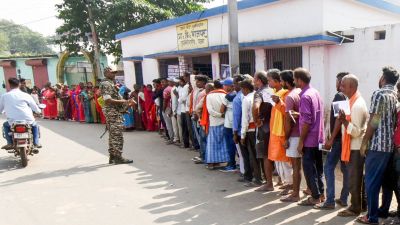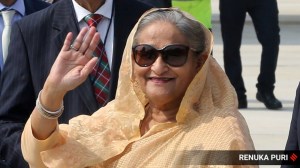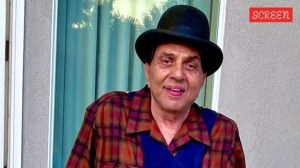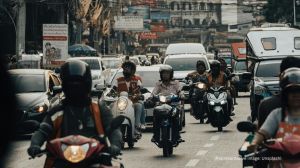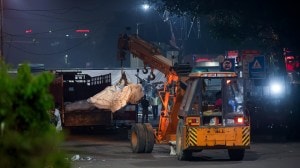Manoj More has been working with the Indian Express since 1992. For the first 16 years, he worked on the desk, edited stories, made pages, wrote special stories and handled The Indian Express edition. In 31 years of his career, he has regularly written stories on a range of topics, primarily on civic issues like state of roads, choked drains, garbage problems, inadequate transport facilities and the like. He has also written aggressively on local gondaism. He has primarily written civic stories from Pimpri-Chinchwad, Khadki, Maval and some parts of Pune. He has also covered stories from Kolhapur, Satara, Solapur, Sangli, Ahmednagar and Latur. He has had maximum impact stories from Pimpri-Chinchwad industrial city which he has covered extensively for the last three decades. Manoj More has written over 20,000 stories. 10,000 of which are byline stories. Most of the stories pertain to civic issues and political ones. The biggest achievement of his career is getting a nearly two kilometre road done on Pune-Mumbai highway in Khadki in 2006. He wrote stories on the state of roads since 1997. In 10 years, nearly 200 two-wheeler riders had died in accidents due to the pathetic state of the road. The local cantonment board could not get the road redone as it lacked funds. The then PMC commissioner Pravin Pardeshi took the initiative, went out of his way and made the Khadki road by spending Rs 23 crore from JNNURM Funds. In the next 10 years after the road was made by the PMC, less than 10 citizens had died, effectively saving more than 100 lives. Manoj More's campaign against tree cutting on Pune-Mumbai highway in 1999 and Pune-Nashik highway in 2004 saved 2000 trees. During Covid, over 50 doctors were asked to pay Rs 30 lakh each for getting a job with PCMC. The PCMC administration alerted Manoj More who did a story on the subject, asking then corporators how much money they demanded....The story worked as doctors got the job without paying a single paisa. Manoj More has also covered the "Latur drought" situation in 2015 when a "Latur water train" created quite a buzz in Maharashtra. He also covered the Malin tragedy where over 150 villagers had died. Manoj More is on Facebook with 4.9k followers (Manoj More), on twitter manojmore91982 ... Read More
Explained: Why Maharashtra ministers wore black bands last Sunday
The Maharashtra government has asked its ministers to wear black bands on November 1 to support the Marathi-speaking people living in border areas of Karnataka and Maharashtra.
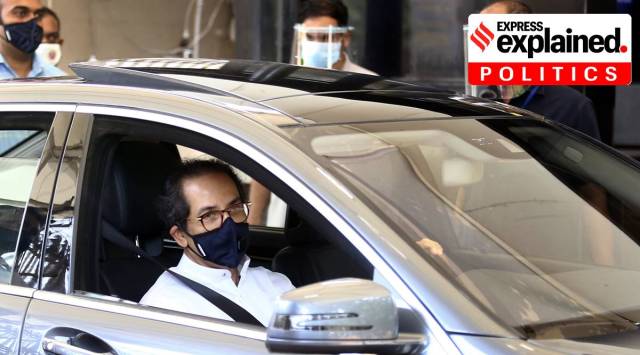 Chief Minister Uddhav Thackeray (Express photo by Nirmal Harindran/File)
Chief Minister Uddhav Thackeray (Express photo by Nirmal Harindran/File)The Maharashtra government led by Chief Minister Uddhav Thackeray has taken a first of its kind step which has “energised” Marathi speaking people living in border areas of Maharashtra and Karnataka. It has asked all its ministers to wear black bands on November 1 to support the Marathi-speaking people living in border areas of Karnataka and Maharashtra.
The state government’s open support by way of ministers wearing black bands has drawn praise from Marathi-speaking people in the border areas and flak from Action Committee of Kannadiga Organisation. Activists of Maharashtra Ekikaran Samiti, which has been spearheading the agitation of Marathi-speaking people for decades, say while the Maharashtra governments earlier gave muted support by merely passing resolution in state assembly expressing support, this time it will be actually participating in the protests.
The state cabinet earlier this week took the “major” step of asking all ministers to work wearing black bands on the Black Day observed in disputed borders areas. PWD Minister Eknath Shinde, who is a Shiv Sena leader, moved the resolution which was seconded by minister Chhagan Bhujbal, an NCP leader. State NCP chief Jayant Patil reasoned that the “major step” was necessary in view of the injustice being meted out to the Marathi speaking people in disputed areas. “All ministers wherever they are will wear black bands to express support to our Marathi brethren in border areas,” he said.
Why November 1?
On November 1, 1960, Karnataka state came into being. While Kannadigas celebrate the state’s formation day as Rajyotsav, Marathi-speaking people stage protests seeking “freedom from Karnataka.” Since November 1, 1956, Marathi-speaking people living in Maharashtra-Karnataka border areas have been observing the day as Black Day. “It was in January 1956, after the report of the Reorganisation of States Commission, that it was decided to merge Belgaum and 10 talukas of Bombay Presidency into the then Mysore state. Later, these talukas became part of Karnataka,” recalled Prof Anand Menase.
Therefore every November 1, rallies are carried out and protests are organised in these 10 talukas by Marathi-speaking people. People wear black bands on their arms and place black flags on their vehicles. To counter the Marathi-speaking people’s protests, Karnataka government machinery organises “rallies with gusto” to celebrate the state’s formation day on November 1. The Karnataka government has also changed the name of Belgaum to Belgavi, though the Maharashtra government still prefers to call it Belgaum.
Karnataka Rajyotsava greetings to my sisters and brothers of Karnataka. Powered by the strength and skills of the people of the state, Karnataka is scaling new heights of progress. I pray for the happiness and good health of the people of Karnataka.
— Narendra Modi (@narendramodi) November 1, 2020
Grievances against Karnataka
Besides demanding a merger with Maharashtra, people living in Marathi-speaking have been protesting against the “injustice” and “atrocities” meted out to them. They alleged that Karnataka government was imposing Kannada on them. The Marathi-speaking people allege that it has been made mandatory for shopkeepers, business establishments and offices to put up their in signboards in Kannad language. In schools, it has been made mandatory to learn Kannada from Class 1 to 10. Industrial units have been directed to give priority in jobs to Kannadigas. In governments too, Kannadigas are given priority. Court functioning is conducted in Kannada language, all government resolutions and circulars are issued in Kannada language.
“Until the last year even voters lists were in Kannad language. After our protests, the list was prepared in both Marathi and Kannada,” said Nemse.
Why are they seeking merger with Maharashtra?
The Marathi-speaking people here argue that the Reorganisation of States Commission had erred in including some border talukas into Karnataka. As per the commission’s recommendation, talukas with more than 50 per cent Kannadiga population were merged with Mysore state. This was not acceptable to the Marathi-speaking people who argue that there are as of today 25 lakh Marathi-speaking living in border areas of Karnataka who are subjected to injustice and had outnumbered Kannadigas even in 1956.
📣 Express Explained is now on Telegram
No opposition to Kannada
The Marathi-speaking people living in the borders are not opposed to Kannada per se, but are against its imposition. Marathi comes naturally to them and they find Kannada difficult to use in their daily lives. “Marathi and Kannad language have their own identities. They are spoken in different style and diction. Those who speak Marathi struggle to speak Kannada as fluently as those who have born and brought in Kannada culture,” argues the Samiti members.
Case Pending in Supreme Court
The Action Committee of Kannidigas has protested against the Maharashtra Government’s decision to observe November 1 as Black Day. The committee has said that when the Maharashtra government has moved the Supreme Court and the boundary dispute was pending in court, the move was a contempt of the court. The committee has described the move as unnecessary and provocative.
The Maharashtra government had moved the Supreme Court in 2004 for a settlement of the border dispute under Article 131(b) of the Constitution. The case is pending in the apex court. In fact, Maharashtra has been seeking readjustment of the border since the States Reorganisation Act came into being in 1957. Maharashtra has been demanding 814 villages from Karnataka on the basis of the theory of village being the unit of calculation, contiguity and enumerating linguistic population in each village. Karnataka has been maintaining that it will not transfer even an inch of land and said that the settlement under States Reorganisation Act was final and not open to any negotiation.





- 01
- 02
- 03
- 04
- 05



